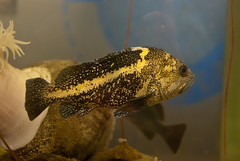 NEWPORT – The Visitor Center at OSU’s Hatfield Marine Science Center has acquired a new octopus for its central display and teaching tank, and aquarists report that the animal is lively, alert and adapting to her quarantine tank in the animal husbandry wing.
NEWPORT – The Visitor Center at OSU’s Hatfield Marine Science Center has acquired a new octopus for its central display and teaching tank, and aquarists report that the animal is lively, alert and adapting to her quarantine tank in the animal husbandry wing.
According to Dennis Glaze, aquatic animal health and husbandry specialist, “Our new octopus arrived in fantastic shape on Wednesday, Pearl Harbor Day. Furthermore, introduction into her temporary holding tank went remarkably smoothly, and not in typical ‘new octopus’ fashion, she seemed quite comfortable hanging around up front of the tank near the viewing window.”
Typically, the Visitor Center quarantines new octopuses for 30 days to acclimate them to human contact and make sure they’re free of disease or parasites. Since this animal came from outside Oregon waters, the Oregon Department of Fish and Wildlife is requiring a 60-day quarantine as a precaution against introducing non-native and potentially invasive organisms into Yaquina Bay via the tank’s seawater system.
The new animal will replace Ursula, the giant Pacific octopus that has occupied the tank since October 2010. The animals are relatively short-lived, and typically stay at the center no longer than a year before being returned to the sea to complete their life cycles. Aquarists began looking for a new octopus when Ursula began showing signs of aging, including laying eggs on the tank’s walls.
Glaze called the newest octopus “a beautiful specimen, about half the size of Ursula.” As with all new arrivals the animal husbandry team watches for signs that the octopus is adapting to her new surroundings, particularly when she starts eating. Some octopuses take weeks to reach out for food, but Glaze said “this little beauty ate the second day of being here at HMSC.”
Update: Since the in-tank Octocam is out of commission (it’s being replaced with a more sophisticated model), the VC tech gurus have focused a temporary Webcam on the quarantine tank. Check the OctoCam page for a sneak preview of the new animal and watch her get acquainted with our animal husbandry staff!
The octopus tank, which is used to teach visitors about octopus biology and behavior, has been a central feature of the Visitor Center since it’s opening, and is among the most popular exhibits with the visiting public. For the past two years, its popularity has spread to to the Internet via the live, streaming OctoCam. (The in-tank camera is currently offline for replacement by a newer, more sophisticated model.)
 Increasing winter storms since the 1980s have been sending higher, harder waves crashing into the Oregon coast, cutting away at seacliffs, roads and infrastructure in an area never known for its seismic stability. Scientists say the increased storm activity is consistent with predictions for the sorts of hazards the world’s coastlines will face as an effect of changing climate.
Increasing winter storms since the 1980s have been sending higher, harder waves crashing into the Oregon coast, cutting away at seacliffs, roads and infrastructure in an area never known for its seismic stability. Scientists say the increased storm activity is consistent with predictions for the sorts of hazards the world’s coastlines will face as an effect of changing climate.




